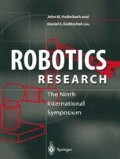Abstract
In this paper, we present a new theory of conservative congruence transformation (CCT) to replace the conventional congruence formulation, K θ = J T θ K p J θ , first derived by Salisbury in 1980. The conservative congruence transformation defines the correct and consistent mapping of the stiffness matrices between the joint and Cartesian spaces. We present the theory and simulation, and show that the conventional formulation is only valid when the manipulator is always maintained at unloaded position. Once the grasping and manipulation are deviated from the unloaded configuration by the application of conservative force, the CCT must be used. The CCT takes into consideration the changes in geometry through the differential Jacobian, or the Hessian, matrix of the robot manipulators. We also show that the omission of the changes in the Jacobian during grasping and manipulation would result in discrepancy of the work, and lead to contradiction to the fundamental physical properties of stiffness control. The CCT, however, preserves the conservative and consistent properties of stiffness control in robotics for the mapping between the joint and Cartesian spaces.
Access this chapter
Tax calculation will be finalised at checkout
Purchases are for personal use only
Preview
Unable to display preview. Download preview PDF.
References
J. K. Salisbury. Active stiffness control of a manipulator in cartesian coordinates. In Proceedings 19th IEEE Conference on Decision and Control, pages 87–97, Albuquerque, NM, December 1980.
I. Kao and C. Ngo. Properties of grasp stiffness matrix and conservative control strategy. the International Journal of Robotics Research, 18 (2): 159–167, 1999.
S.-F. Chen and I. Kao. Extended congruence transformation for joint and cartesian stiffness matrices of robotic hands and fingers. Technical Report TR9901, SUNY at Stony Brook, Department of Mechanical Engineering, Stony Brook, NY 11794–2300, February 1999.
F. M. Dimentberg. The screw calculus and its applications in mechanics. Technical Report FTD–HT23–1632–67, Foreign Technology Division, Wright–Patterson Air Force Base, 1965.
R. S. Ball. A Treaties on The Theory of Screws. Cambridge University Press, 1900.
J. Loncaric. Geometrical Analysis of Compliant Mechanisms in Robotics. PhD thesis, Harvard University, 1985.
M. R. Cutkosky and I. Kao. Computing and controlling the compliance of a robotic hand. IEEE Transaction of Robotics and Automation, 5 (2): 151–165, April 1989.
E. A. Mussa-Ivaldi, N. Hogan, and E. Bizzi. Neural, mechanical, and geometric factors subserving arm posture in humans. The Journal of Neuroscience, 5 (10): 2732–2743, October 1985.
J. Kerr and B. Roth. Analysis of multifingered hands. The International Journal of Robotics Research, 4 (4): 3–17, 1986.
I. Kao. Stiffness control and calibration of robotic and human hands and fingers. In Proceedings of 1994 IEEE Conference on Robotics and Automation, pages 399–406, San Diego, California, May 8–13 1994.
J. Li and I. Kao. Grasp stiffness matrix — fundamental properties in analysis of grasping and manipulation. In Proceedings of the 1995 IEEE/RSJ International Conference on Intelligent Robots and Systems, pages 381–386. IEEE, August 1995.
I. Kao, M. R. Cutkosky, and R. S. Johansson. Robotic stiffness control and calibration as applied to human grasping tasks. IEEE Transaction of Robotics and Automation, 13 (4): 557–566, 1997.
V. Nguyen. Constructing stable grasps. The International Journal of Robotics Research, 8 (1): 26–37, Feburary 1989.
N. Hogan. Impedance control: An approach to manipulation: Part i, ii, and iii. Journal of Dynamic Systems, Measurement, and Control, Transactions of the ASME, 107: 1–24, March 1985.
N. Hogan. Mechanical impedance of single- and multiarticular systems. In J. M. Winters and S. L.-Y. Woo, editors, Multiple Muscle Systems: Biomechanics and Movement Organization, pages 149–164, New, York, 1990. Springer-Verlag.
T. Pigoski, N. Ciblak, and H. Lipkin. Stiffness mappings employing different frames of reference. In Proceedings of the 22nd Biennial ASME Mechanisms Conference, volume DE-Vol. 47, pages 445–452. ASME, September 1992.
M. Griffis and J. Duffy. Global stiffness modeling of a class of simple compliant couplings. Mechanisms and Machine Theory, 28 (2): 207–224, 1993.
N. Ciblak and H. Lipkin. Asymmetric cartesian stiffness for the modeling of compliant robotic systems. In ASME Conference — Robotics: Kinematics, Dynamics, and Control, DE-Vol. 72, pages 197–204. ASME, 1994.
M. Zefran and V. Kumar. Affine connections for the cartesian stiffness matrix. In Proceeding of IEEE International Conference on Robotics and Automation, pages 1376–1381, 1997.
S. Howard, M. Zefran, and V. Kumar. On the 6×6 stiffness matrix for three dimensional motions. Mechanism and Machine Theory, 33 (4): 389–408, May 1998.
S.-F. Chen and I. Kao. Simulation of conservative properties of stiffness matrices in congruence transformation. In Proceedings of 7 EEE/RSJ Internatioanl Conference on Intelligent Robots and Systems, pages 311–316, Canada, October 1998.
Author information
Authors and Affiliations
Editor information
Editors and Affiliations
Rights and permissions
Copyright information
© 2000 Springer-Verlag London
About this paper
Cite this paper
Chen, SF., Kao, I. (2000). Theory of Stiffness Control in Robotics Using the Conservative Congruence Transformation. In: Hollerbach, J.M., Koditschek, D.E. (eds) Robotics Research. Springer, London. https://doi.org/10.1007/978-1-4471-0765-1_2
Download citation
DOI: https://doi.org/10.1007/978-1-4471-0765-1_2
Publisher Name: Springer, London
Print ISBN: 978-1-4471-1254-9
Online ISBN: 978-1-4471-0765-1
eBook Packages: Springer Book Archive

